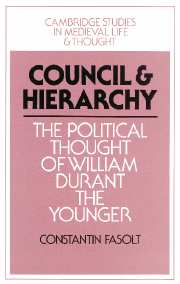Book contents
- Frontmatter
- Contents
- Acknowledgments
- List of abbreviations
- List of manuscript sigla
- INTRODUCTION
- PART I THE FORMATION OF INTEREST
- PART II THE ASSERTION OF JUSTICE
- 4 THE THEORY OF REFORM
- 5 ‘MAGNUS ORDO DIFFERENTIE’
- 6 ‘RES PUBLICA’
- 7 THE PERVERSION OF ORDER
- RESULTS: LIBERTY AND LAW
- PART III THE INCIDENCE OF POWER
- CONCLUSION
- Appendix: A note on texts and citations
- Bibliography
- Concordance
- Index
- Cambridge studies in medieval life and thought Fourth series
5 - ‘MAGNUS ORDO DIFFERENTIE’
Published online by Cambridge University Press: 06 July 2010
- Frontmatter
- Contents
- Acknowledgments
- List of abbreviations
- List of manuscript sigla
- INTRODUCTION
- PART I THE FORMATION OF INTEREST
- PART II THE ASSERTION OF JUSTICE
- 4 THE THEORY OF REFORM
- 5 ‘MAGNUS ORDO DIFFERENTIE’
- 6 ‘RES PUBLICA’
- 7 THE PERVERSION OF ORDER
- RESULTS: LIBERTY AND LAW
- PART III THE INCIDENCE OF POWER
- CONCLUSION
- Appendix: A note on texts and citations
- Bibliography
- Concordance
- Index
- Cambridge studies in medieval life and thought Fourth series
Summary
The orders of the church have been divided and ranked for the concord of the human race, as Pope Leo has said, so that no schism would befall the church of God, as Jerome demonstrated to Bishop Evandrus.
William DurantThis, then, was the argument for reforming the church by general councils that William Durant the Younger presented in the first part of his treatise. It pretended to rest on a coherent vision of law and order – but we have already suggested that beneath this placid surface there was a veritable abyss of doubts. The nature of those doubts still needs to be identified, and the broader programme of reform that was contained in the second part of the Tractatus Maior, as well as its relationship to the conciliar proposal, still need to be considered. These are the tasks to which the following three chapters are dedicated.
Part of the reason why so much uncertainty has beset the study of Durant's intentions is that he never took the time to specify his purpose in any systematic way. He did say that he aimed at a ‘healthy regime for the human race’ and that according to St Paul the powers that be are ordained by God and therefore ought to conform to God's commands. He also made numerous suggestions how to improve this or that aspect of the world.
- Type
- Chapter
- Information
- Council and HierarchyThe Political Thought of William Durant the Younger, pp. 177 - 216Publisher: Cambridge University PressPrint publication year: 1991



